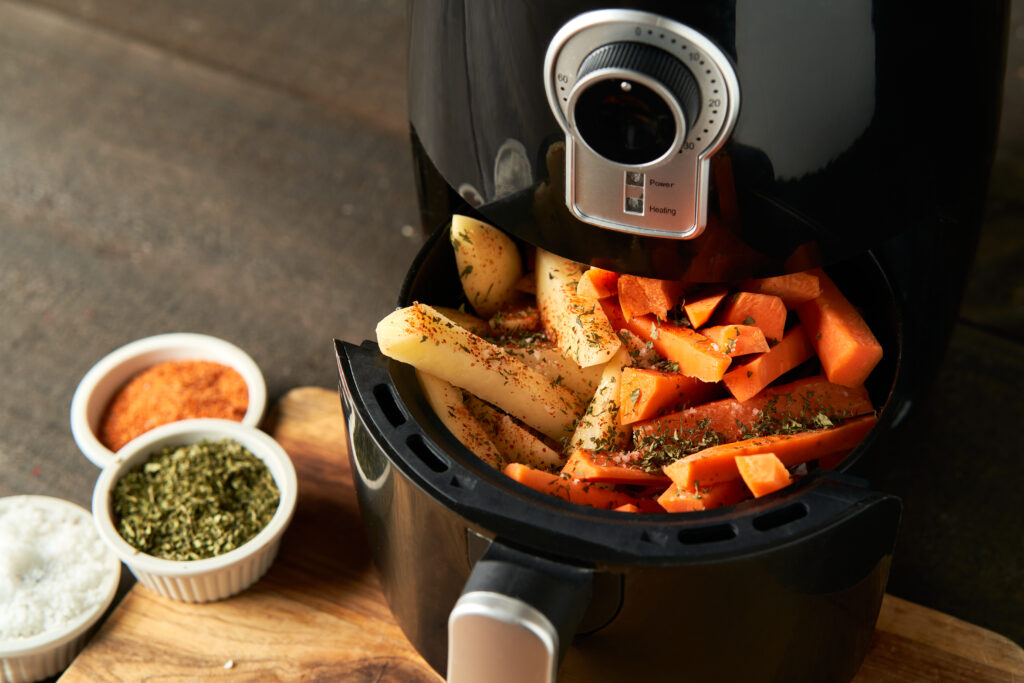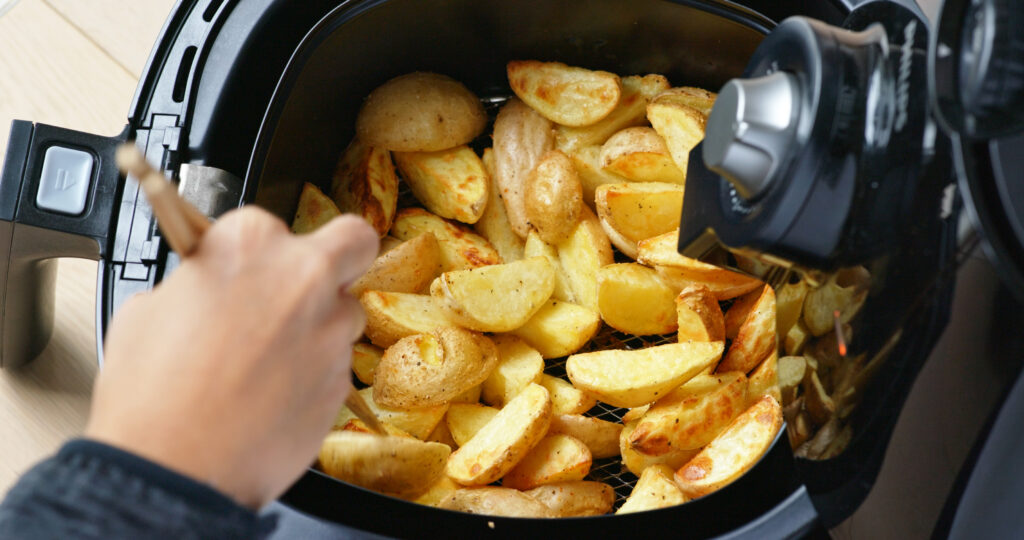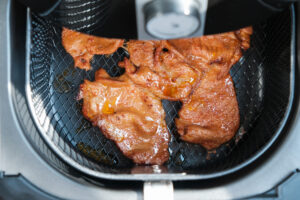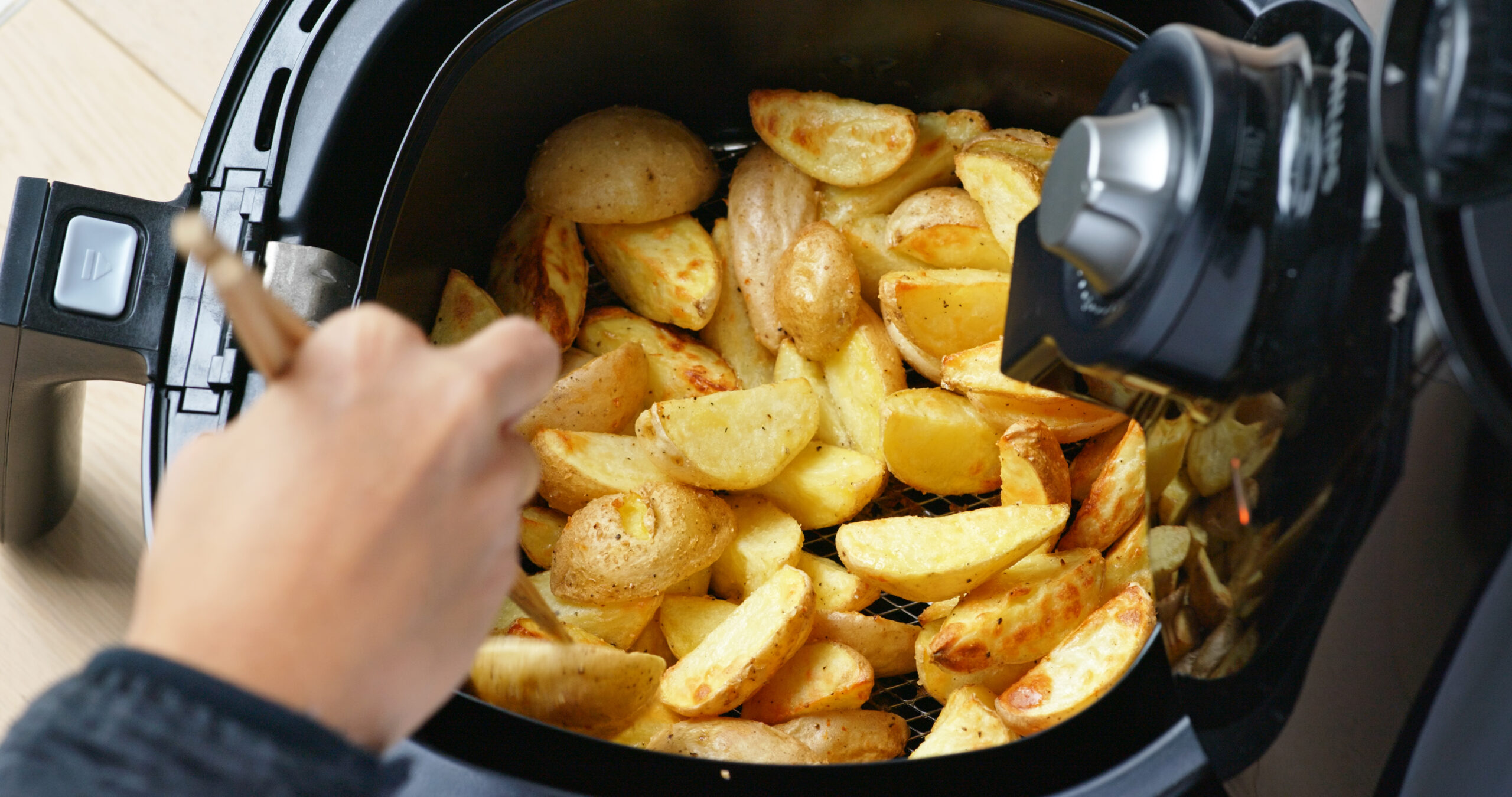Imagine being able to enjoy your favorite fried foods without the guilt of consuming excessive oil and calories. With an air fryer, this can become a reality.
In this article, we will explore the benefits of using an air fryer, such as healthier cooking options, reduced oil consumption, faster cooking times, and versatile cooking methods.
Additionally, we will delve into how an air fryer works, including the use of rapid air technology, a heating element, an air circulation system, and a cooking chamber. By following these air fryer safety tips, you can cook with confidence and enjoy delicious and healthier meals.
Benefits of Using an Air Fryer
Healthier Cooking Option
Using an air fryer can offer a healthier cooking option compared to traditional frying methods. Air fryers use hot air circulation to cook food, rather than submerging it in oil. This means that you can enjoy fried food with significantly less oil or even no oil at all.
By reducing the amount of oil in your meals, you can decrease your calorie and fat intake, making it a suitable option for those looking to watch their weight or maintain a healthy lifestyle.
Additionally, air frying can also help to reduce the risk of consuming harmful acrylamide, a chemical compound that forms when certain starchy foods are cooked at high temperatures.
Reduced Oil Consumption
One of the major benefits of using an air fryer is its ability to reduce oil consumption. Traditional frying methods often require a large quantity of oil to fully submerge the food, resulting in a greasy and calorie-laden dish.
With an air fryer, only a minimal amount of oil is needed, or in some cases, no oil at all. The hot air circulation technology allows the food to be cooked evenly and achieve a crispy texture without the need for excessive oil.
This not only makes your meals healthier but also saves you money on buying and disposing of large amounts of cooking oil.
Faster Cooking Time
Air fryers are known for their ability to cook food faster than traditional methods. The rapid air technology used in air fryers ensures that hot air is distributed evenly throughout the cooking chamber, leading to quicker and more efficient cooking.
This means that you can enjoy your favorite fried foods in a fraction of the time it would take in a conventional oven or stovetop.
Whether it’s crispy french fries, tender chicken wings, or flaky fish fillets, an air fryer can significantly cut down on cooking time, allowing you to enjoy your meals without having to wait for ages.
Versatile Cooking Methods
Another great advantage of using an air fryer is its versatility in cooking various types of food. While the name implies that it is primarily used for frying, an air fryer can actually handle a wide range of cooking techniques.
You can not only fry food but also roast, grill, bake, and even reheat leftovers using an air fryer. This versatility makes it a valuable addition to any kitchen, as it allows you to experiment with different recipes and prepare a variety of meals with ease.
From crispy vegetables to juicy steaks, an air fryer can cater to all your culinary needs.
How Does an Air Fryer Work?
Rapid Air Technology
The main principle behind the functionality of an air fryer is the rapid air technology it employs. This technology involves the circulation of hot air around the food at high speeds, resulting in a crispy exterior and evenly cooked interior.
The air fryer has a heating element that produces the heat required for cooking. The hot air is then rapidly circulated by a fan, creating a continuous flow of heated air within the cooking chamber.
The constant movement of hot air ensures that the food is cooked uniformly and efficiently.
Heating Element
The heating element of an air fryer is responsible for generating the heat necessary for cooking. Typically located at the top of the appliance, the heating element quickly heats up and transfers the heat to the air within the cooking chamber.
It is designed to reach high temperatures to ensure fast and effective cooking. The heating element is equipped with temperature controls that allow you to set the desired cooking temperature for different recipes.
Air Circulation System
The air circulation system of an air fryer plays a crucial role in the cooking process. It consists of a powerful fan that circulates the hot air generated by the heating element throughout the cooking chamber. This constant movement of hot air ensures that the food is evenly cooked from all sides.
The circulating air also helps to remove excess moisture from the food, resulting in a crispy and golden-brown exterior.
Cooking Chamber
The cooking chamber is where the magic happens in an air fryer. It is a spacious, non-stick basket that holds the food during the cooking process.
The basket is designed with holes or a mesh bottom to allow the hot air to circulate around the food, ensuring even cooking. Most air fryers come with a removable basket, making it easy to transfer the cooked food to a serving dish or to clean the basket after use.
The cooking chamber is also equipped with a drip tray at the bottom to collect any excess oil or juices that may be released during cooking, making it easier to clean up afterward.

Safety Precautions Before Cooking
Read the Instruction Manual
Before using an air fryer, it is important to thoroughly read and understand the instruction manual provided by the manufacturer. The manual contains valuable information about the specific features, functions, and safety precautions of the air fryer.
Familiarize yourself with the operating procedures, temperature settings, and any limitations or warnings mentioned in the manual. Following the instructions provided by the manufacturer will ensure that you use the air fryer safely and avoid any potential hazards.
Place the Air Fryer on a Stable Surface
When setting up your air fryer, it is essential to place it on a stable and heat-resistant surface. The air fryer can generate heat during operation, so it is important to avoid placing it on surfaces that may be easily damaged or catch fire, such as wooden countertops or near flammable objects.
Opt for a flat and sturdy surface that can withstand the weight of the air fryer and provide adequate stability to prevent any accidental tipping or falls during the cooking process.
Ensure Proper Ventilation
Air fryers require proper ventilation to function efficiently and safely. Make sure to place the air fryer in an open area with sufficient space around it to allow for adequate airflow.
It is crucial to avoid placing the air fryer too close to walls, cabinets, or other appliances that may obstruct the airflow or accumulate heat. Adequate ventilation ensures that the hot air can circulate freely and prevents the air fryer from overheating, which can lead to malfunctions or pose a fire hazard.
Clean the Air Fryer Regularly
To maintain the optimal performance and safety of your air fryer, it is important to clean it regularly. After each use, allow the air fryer to cool down completely before handling or cleaning. Remove the cooking basket and drip tray and wash them with warm, soapy water. Use a non-abrasive sponge or cloth to gently wipe the interior and exterior of the air fryer.
Avoid using harsh chemicals or abrasive cleaning agents, as they can damage the non-stick coating. Regular cleaning not only keeps your air fryer in good condition but also ensures that there are no leftover food particles or grease buildup that can affect the taste and quality of your future meals.
Check the Power Supply
Before turning on the air fryer, make sure to check the power supply and ensure that it is stable and grounded. It is important to use the air fryer with a grounded electrical outlet to prevent electrical shocks or short circuits.
Avoid using extension cords or power strips, as they may not be able to handle the power requirements of the air fryer and can pose a safety risk. Always plug the air fryer directly into a wall outlet that is compatible with its power rating.
Avoid Overloading the Air Fryer
To ensure safe and efficient cooking, it is crucial to avoid overloading the air fryer by putting too much food in the cooking chamber. Overfilling the basket can obstruct the airflow and prevent the hot air from circulating properly, resulting in unevenly cooked food.
The air fryer should be filled with a single layer of food, leaving enough space for the hot air to circulate around each piece. If you have a large quantity of food to cook, consider cooking it in batches to maintain optimal cooking conditions and ensure food safety.
Safety Tips While Cooking
Avoid Overfilling the Basket
When cooking food in an air fryer, it is important to avoid overfilling the cooking basket. Overfilling can lead to uneven cooking and prevent the hot air from circulating properly. To ensure that the food is evenly cooked and crispy, leave enough space between the food items in the basket.
This allows the hot air to circulate freely and ensures that each piece of food receives equal heat distribution. If you have a large quantity of food to cook, consider cooking it in multiple batches to maintain the best cooking results.
Prevent Oil Splatters
Even though air frying requires less oil compared to traditional frying, there may still be instances where oil splatters occur. To prevent oil splatters, make sure to pat dry the food before placing it in the air fryer. Excess moisture on the food can cause the oil to splatter when it comes in contact with the hot air.
Additionally, avoid overcrowding the cooking basket, as this can also lead to oil splatters. If you are adding oil to your food, use a cooking spray or brush to evenly distribute the oil, minimizing the chances of oil splatters.
Use Oven Mitts or Heat-Resistant Gloves
During the cooking process, the air fryer and its accessories can become extremely hot. To protect yourself from burns or injuries, always use oven mitts or heat-resistant gloves when handling the air fryer or removing the hot basket or tray.
The non-stick coating of the cooking basket and other parts can retain heat for some time after cooking, so it is important to let them cool down before touching them directly.
Using oven mitts or heat-resistant gloves provides an extra layer of protection and ensures safe handling of hot components.
Do Not Touch Hot Surfaces
It is crucial to refrain from touching the hot surfaces of the air fryer during and immediately after cooking. The exterior of the air fryer, including the control panel and handles, can become very hot during operation.
Touching these hot surfaces without proper protection can result in burns or injuries. Always use oven mitts or heat-resistant gloves when handling the air fryer, even if you are just adjusting the temperature or timer. Allow the air fryer to cool down before attempting to clean it or move it to a different location.
Avoid Water Contact
Air fryers should never come in contact with water or other liquids, especially when they are hot. Water can cause electrical shocks and damage the internal components of the air fryer. Avoid washing the air fryer while it is plugged in or still hot.
Always unplug the air fryer and allow it to cool down completely before cleaning. Use a damp cloth or sponge to wipe the exterior and removable parts.
If any liquid accidentally spills inside the air fryer, make sure to unplug it immediately and let it dry completely before using it again.
Do Not Leave the Air Fryer Unattended
It is important to stay vigilant and never leave the air fryer unattended while it is in operation. Although air fryers are generally safe to use, accidents can happen.
Keeping an eye on the air fryer ensures that you can quickly respond to any issues or prevent any potential hazards. Stay near the kitchen while using the air fryer and remember to use a timer to avoid overcooking or burning your food.
Promptly remove the food from the air fryer once it is cooked to prevent further cooking and potential overheating.
Best Seller!
Temperature and Timer Precautions
Preheat the Air Fryer
Preheating the air fryer is crucial for achieving the best cooking results. Just like with traditional ovens, preheating allows the air fryer to reach the desired cooking temperature before placing the food inside.
This helps to ensure even cooking and a crispy texture. Most air fryers come with a preheat function or setting. To preheat the air fryer, simply set the temperature to the desired level and allow it to heat up for a few minutes.
Once the air fryer is preheated, you can add your food and begin the cooking process.
Set the Correct Cooking Temperature
Setting the correct cooking temperature is essential when using an air fryer. Different foods require different cooking temperatures to ensure proper cooking and achieve the desired texture and taste. Consult your recipe or cooking guidelines to determine the appropriate cooking temperature for your specific dish.
Most air fryers have temperature controls that allow you to easily adjust and set the desired temperature. Be sure to follow the recommended temperature and avoid setting it too high, as this can result in burnt or overcooked food.

Cooking tips from Famous Chefs
Monitoring the cooking time is important to prevent overcooking or undercooking your food. Set the timer according to the recommended cooking time for your recipe. While the air fryer may have a built-in timer, it is also beneficial to set an additional timer or use a kitchen timer as a backup.
This way, you can keep track of the cooking time and ensure that your food is cooked to perfection. It is advisable to check your food a few minutes before the recommended cooking time is up to prevent overcooking and make any necessary adjustments.
Best Seller!
Adjust Settings When Necessary
During the cooking process, it is important to periodically check on your food and adjust the settings if necessary. If you notice that your food is browning too quickly or not cooking evenly, you may need to lower the cooking temperature or adjust the cooking time.
Each air fryer may have slight variations in temperature and cooking efficiency, so it is essential to observe and adapt accordingly. Pay attention to the appearance and texture of your food and make any necessary adjustments to achieve the desired results.
Food Preparation Guidelines
Thaw Frozen Ingredients
When using an air fryer, it is important to thaw frozen ingredients before cooking them. Thawing the food allows for more even cooking and ensures that the interior is thoroughly cooked without overcooking the exterior. Most air fryers are not designed to cook frozen food directly, as it can lead to uneven results and prolong the cooking time.
To thaw frozen ingredients, you can either transfer them from the freezer to the refrigerator overnight or use the defrost function of your microwave. Properly thawed ingredients will result in better flavor and texture.
Pat Dry the Food
Before placing the food in the air fryer, it is advisable to pat dry it with a paper towel or clean kitchen towel. Excess moisture in the food can affect the cooking process and result in less crispy and evenly cooked results.
Moisture can also lead to oil splatters when it comes in contact with the hot air. By thoroughly patting dry the food, you can ensure that it will cook evenly and achieve the desired texture. Be sure to remove any excess water or liquid from the surface of the food before seasoning or adding oil.
Cut Ingredients into Uniform Sizes
To ensure even cooking and consistent results, it is important to cut the ingredients into uniform sizes. When the pieces are of the same size, they will cook at the same rate and achieve a consistent texture.
Unevenly sized ingredients can lead to some pieces being undercooked or overcooked. For example, when making homemade french fries, cutting the potatoes into uniform sticks will ensure that each fry cooks evenly and achieves a crispy exterior.
Take the time to carefully cut your ingredients into similar sizes for optimal results.
Season Food Before Cooking
Seasoning your food before cooking is essential to enhance its flavor and ensure that it is evenly seasoned throughout. Before placing the food in the air fryer, take the time to season it with your desired spices, herbs, or marinades.
You can use a variety of seasonings, such as salt, pepper, garlic powder, paprika, or even a pre-made seasoning blend. By seasoning the food before cooking, the flavors will penetrate the ingredients and result in a more flavorful end product.
Remember to adjust the amount of seasoning based on your personal taste preferences.
Use Cooking Sprays or Brush
While air fryers require less oil compared to traditional frying methods, it is still beneficial to use a small amount of oil to achieve a crispy and golden-brown exterior. Instead of pouring oil directly onto the food, which can result in uneven distribution, opt for cooking sprays or a brush to apply a thin layer of oil on the surface of the food.
This ensures that the oil is evenly spread, leading to a consistent texture and flavor. Using a cooking spray or brush also helps in reducing oil consumption and preventing oil splatters.
Avoid Overcrowding the Basket
To achieve the best cooking results, it is important to avoid overcrowding the cooking basket of the air fryer. Overcrowding can lead to uneven cooking and prevent the hot air from circulating properly around each piece of food. To ensure even cooking and a crispy texture, leave enough space between each piece of food in the basket.
If you have a large quantity of food to cook, it is recommended to cook it in multiple batches, allowing the air fryer to work efficiently. This way, each piece of food will have enough room to cook evenly and achieve the desired results.

Safe Handling of Hot Food
Use Tongs or Silicone Utensils
When removing cooked food from the air fryer, it is important to use tongs or silicone utensils to prevent burns or injuries. These tools provide a safe and secure grip on the hot food, allowing you to transfer it to a serving plate without direct contact with your hands.
Avoid using metal utensils or sharp objects, as they can damage the non-stick coating of the cooking basket and potentially cause scratches or flakes to mix with your food.
Silicone or heat-resistant utensils are safe to use with your air fryer and prevent any damage to the interior or exterior.
Allow Food to Cool
After cooking, it is crucial to allow the food to cool for a few minutes before consuming or transferring it to a serving plate. This allows the food to set and firm up, ensuring that it retains its shape and texture when served.
Hot food can be more prone to falling apart or becoming mushy if it is immediately handled or cut into. Giving the food a few minutes to cool down not only makes it easier to handle but also prevents any burns or injuries that could occur from consuming food that is too hot.
Transfer Food to the Serving Plate
When removing food from the air fryer, it is advisable to transfer it to a serving plate or dish instead of eating directly from the basket. Transferring the food allows for easier serving and prevents any potential harm or damage that may occur from accidentally touching hot surfaces.
Use tongs or a silicone spatula to gently transfer the food, ensuring that any excess oil or liquid is left behind in the cooking basket. This will help to maintain the crispy texture of the food and prevent it from becoming soggy.
Keep Children and Pets Away
While using an air fryer, it is important to keep children and pets away from the cooking area to prevent any accidents or injuries. The air fryer generates high temperatures and can pose dangers to curious hands or paws. Make sure to set up a designated cooking area where children and pets are not allowed to approach or touch the air fryer.
Keep them at a safe distance and educate them about the potential hazards associated with hot appliances. This will ensure a safe cooking environment for everyone involved.
Avoid Direct Skin Contact
Hot food and surfaces can cause burns or injuries if they come in contact with bare skin. It is crucial to avoid direct skin contact with the hot food or the interior and exterior of the air fryer. Always use oven mitts or heat-resistant gloves when handling the air fryer, removing hot food, or touching any surfaces that have been in contact with heat.
This will protect your hands from burns and ensure safe handling during the cooking and serving process. Additionally, avoid leaning or reaching over the air fryer while it is in operation to prevent accidental burns.
Cleaning and Maintenance
Unplug the Air Fryer Before Cleaning
Before starting the cleaning process, it is essential to unplug the air fryer and ensure that it is not connected to any power source. This prevents any risk of electrical shocks or accidents while handling the appliance.
Always check that the air fryer is completely powered off and allow it to cool down before proceeding with cleaning.
Allow the Air Fryer to Cool Down
Before cleaning the air fryer, make sure that it has cooled down completely. The heating element and other components can retain heat even after the cooking process is completed.
Wait for the air fryer to reach room temperature or cool down for at least 30 minutes before handling or cleaning. This reduces the risk of burns and ensures safe maintenance.
Wash Removable Parts
Most air fryers come with removable parts that can be easily washed. Remove the cooking basket and drip tray from the air fryer and wash them with warm, soapy water. Use a sponge or cloth to gently scrub away any food residues or oil buildup.
Rinse the parts under running water to remove any soap residue. Make sure to dry the parts thoroughly before placing them back into the air fryer. Avoid using abrasive sponges or brushes that can damage the non-stick coating.
Wipe the Exterior
To clean the exterior of the air fryer, use a damp cloth or sponge to wipe away any grease or dirt. If there are stubborn stains or residues, use a mild dishwashing liquid or a non-abrasive cleaner to remove them.
It is important to avoid getting any liquid into the control panel or any other openings of the air fryer. Wipe the exterior dry with a clean cloth to prevent water spots or streaks.
Remove Oil Residue
Over time, oil residue can accumulate and build up in the air fryer. To remove stubborn oil residue, mix baking soda with water to form a paste. Apply the paste to the affected areas and let it sit for a few minutes.
Gently scrub the residue with a non-abrasive sponge or cloth. Rinse with water and dry thoroughly. This will help to remove any oil buildup and maintain the performance of the air fryer.
Store the Air Fryer Properly
When not in use, it is important to store the air fryer properly to protect it from damage and ensure its longevity. Allow the air fryer to cool down completely before storing.
Make sure that all removable parts are clean and dry before assembling them back into the air fryer. Store the air fryer in a dry and cool place, away from direct sunlight or extreme temperatures. Keep it in a place where it is easily accessible for future use.
Troubleshooting Common Issues
Uneven Cooking
If you notice that certain areas of your food are cooking faster or slower than others, it may be due to uneven air circulation. Make sure that the hot air can circulate freely around the food by avoiding overcrowding the cooking basket.
Arrange the food in a single layer, leaving enough space between each piece. If the issue persists, try rotating the food halfway through the cooking process to ensure even cooking on all sides.
Food Sticking to the Basket
To prevent food from sticking to the cooking basket, make sure to preheat the air fryer before adding the food. This helps to create a non-stick surface. Lightly greasing the cooking basket with cooking spray or oil can also help prevent sticking.
If you are cooking foods with a high moisture content, such as certain vegetables or seafood, try patting them dry before placing them in the air fryer to minimize sticking.
Air Fryer Not Heating Up
If your air fryer is not heating up, there may be an issue with the power supply. Make sure that the air fryer is plugged in properly and connected to a grounded electrical outlet.
Check if there is any damage to the power cord or if the outlet is functioning. If the air fryer still does not heat up, it may be a malfunction that requires professional assistance. Contact the manufacturer’s customer service for further guidance or troubleshooting.
Excessive Smoke
Excessive smoke during the cooking process can be caused by various factors. Firstly, check if there is any food debris or oil buildup in the cooking chamber or on the heating element.
Remove any residues and ensure that the air fryer is clean before using it again. Excessive smoke can also occur if you are using high-fat oils with a low smoke point. Consider switching to oils with higher smoke points, such as canola or avocado oil, to reduce smoke production.
Strange Odors
If you notice strange odors coming from the air fryer, it may be a result of food residue or oil buildup. Regularly clean the air fryer to remove any lingering smells. Some foods, such as fish or strongly flavored spices, can leave lingering odors in the air fryer.
To combat this, wipe the interior of the air fryer with a mixture of water and vinegar, or place a bowl of baking soda inside the air fryer and leave it overnight to absorb the odors.
Error Messages on Display
If your air fryer displays error messages, refer to the instruction manual provided by the manufacturer for guidance. The error messages can indicate various issues, such as temperature sensor problems or power supply malfunctions.
Follow the troubleshooting steps recommended by the manufacturer or contact their customer service for further assistance. It is important not to attempt any repairs on your own, as it may void the warranty or cause further damage.
Conclusion
Using an air fryer offers a multitude of benefits, from healthier cooking options to faster cooking times. By utilizing rapid air technology, air fryers allow you to enjoy crispy and delicious meals with reduced oil consumption.
It is important to follow safety precautions and tips to ensure safe usage of your air fryer. Proper handling, cleaning, and maintenance will contribute to the longevity and optimal performance of your appliance.
By embracing the benefits of air frying and cooking with confidence, you can enjoy a wide variety of safe and delicious recipes in the comfort of your own home.
Best Seller!
Happy Cooking!



